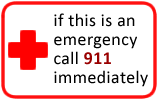Finger Injury
Finger Injury
Does this describe your symptoms? |
Click image for more info |
Definition
Types of Injuries
When are Stitches Needed?
|
If not, see these topics
First Aid:FIRST AID Advice for Bleeding: Apply direct pressure to the entire wound with a clean cloth. FIRST AID Advice for Penetrating Object: If penetrating object still in place, don't remove it (Reason: removal could increase bleeding). FIRST AID Advice for Shock: Lie down with feet elevated. FIRST AID Advice for a Sprain of the Finger:
FIRST AID Advice for Suspected Fracture or Dislocation of the Finger:
FIRST AID Advice for Transport of an Amputated Finger:
|
When to Call Your Doctor |
Call 911 Now (you may need an ambulance) If |
|
|
|
Call Your Doctor Now (night or day) If |
|
|
|
Call Your Doctor Within 24 Hours (between 9 am and 4 pm) If |
|
|
|
Call Your Doctor During Weekday Office Hours If |
|
|
|
Self Care at Home If |
|
|
HOME CARE ADVICE FOR MILD INJURIES OF FINGER |
Treatment of Cuts, Scratches and Scrapes (abrasions):
Apply direct pressure for 10 minutes to stop any bleeding.
Wash the wound with soap and water for 5 minutes.
Scrub out any dirt gently with a washcloth.
Cut off any pieces of dead loose skin using fine scissors (clean scissors with rubbing alcohol before and after use).
Apply an antibiotic ointment, covered by a Band-Aid or dressing. Change daily.
Treatment of Bruised Finger: Soak the finger in cold water for 20 minutes.
Treatment of Jammed Finger:
Caution - Be certain range of motion is normal (can bend and straighten each finger).
Soak the finger in cold water for 20 minutes.
If the pain is more than mild, protect it by "buddy-taping" it to the next finger
Treatment of Smashed or Crushed Fingertip:
Apply an ice bag to the area for 20 minutes.
Wash the finger with soap and water for 5 minutes.
Trim any small pieces of torn dead skin with a scissors cleaned with rubbing alcohol.
Cover any cuts with an antibiotic ointment and Band-Aid. Change daily.
Treatment of Subungual Hematoma (blood under the nail): Apply an ice bag to the area for 20 minutes.
Torn Nail (from catching it on something):
For a cracked nail without rough edges, leave it alone.
For a large flap of nail that is almost torn through, use a sterile scissors to cut it off along the line of the tear (Reason: pieces of nail will catch on objects and tear further).
Apply an antibiotic ointment and cover with a Band-Aid. Change daily.
After about 7 days, the nail bed should be covered by new skin and no longer hurt. It takes about 6-12 weeks for a fingernail to grow back completely.
Pain Medicines:
For pain relief, take acetaminophen, ibuprofen, or naproxen.
Acetaminophen (e.g., Tylenol):
Take 650 mg by mouth every 4-6 hours. Each Regular Strength Tylenol pill has 325 mg of acetaminophen.
Another choice is to take 1,000 mg every 8 hours. Each Extra Strength Tylenol pill has 500 mg of acetaminophen.
The most you should take each day is 3,000 mg.
Ibuprofen (e.g., Motrin, Advil):
Take 400 mg by mouth every 6 hours.
Another choice is to take 600 mg by mouth every 8 hours.
Use the lowest amount that makes your pain feel better.
Naproxen (e.g., Aleve):
Take 250-500 mg by mouth every 12 hours.
Use the lowest amount that makes your pain feel better.
Extra Notes:
Acetaminophen is thought to be safer than ibuprofen or naproxen in people over 65 years old. Acetaminophen is in many OTC and prescription medicines. It might be in more than one medicine that you are taking. You need to be careful and not take an overdose. An acetaminophen overdose can hurt the liver.
Caution: Do not take acetaminophen if you have liver disease.
Caution: Do not take ibuprofen or naproxen if you have stomach problems, kidney disease, are pregnant, or have been told by your doctor to avoid this type of medicine. Do not take ibuprofen or naproxen for more than 7 days without consulting your doctor.
Before taking any medicine, read all the instructions on the package
Call Your Doctor If:
Cut or scrape looks infected (redness, red streak or pus)
Pain becomes severe
Pain does not improve after 3 days
Pain or swelling lasts more than 2 weeks
You become worse
And remember, contact your doctor if you develop any of the "Call Your Doctor" symptoms.
Updated:
March 22, 2017







